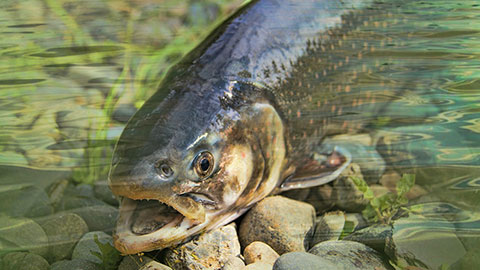Brown Trout Benefit from the Restoration of Spawning and Nursery Grounds
The new genetic analysis methods applied by researchers of the University of Turku and Estonian University of Life Sciences reveal that restored spawning grounds and rapids produce higher population densities in brown trout and increase the vitality of rivers and streams.

Hydroelectric projects, cleaning rivers for log driving and other alterations caused by humans are a worldwide threat to the existence of salmonoid species. This is also the situation in Finland, where the combined effect of scattered spawning and nursery grounds and the large amount of sediments produced by agriculture diminishes the vitality of trout and salmon.
There have been several restoration projects of river beds in Finland and all over the world, which aim at improving the salmonoids' growth environment. The projects have often been carried out by local volunteers, but their biological effects have rarely been proven.
In a recently published study, Academy Researcher Anti Vasemägi from the University of Turku has evaluated the effectiveness of the restoration of river beds in brown trout's spawning and nursery grounds in relation to the production of offspring. For two years, Vasemägi studied restored trout rivers and streams in Estonia and compared his results with rivers that were in their natural state. In order to evaluate the number of adult, spawning fish, the research group used a new analysis method, which uses molecular genetics and produces demographic information from the DNA of juvenile trout.
– The corresponding number of offspring and breeding fish in restored and natural rivers indicates that trout benefit from the restorations. This is great news for the local restoration projects. Improved spawning grounds and restored rapids produce larger populations and increase the vitality of trout rivers, says Vasemägi.
Molecular Genetic Analysis Useful in Studying Endangered Fish
Researcher Mikhail Ozerov, who was part of the research group, says that including the genetic reconstruction analysis in future research on fish populations can produce new and useful information for decision-makers.
– The molecular genetic analysis is particularly useful in studying endangered fish. The estimation of the number of breeding fish, which is based on the DNA analysis of juvenile fish, is particularly important for conservation. At some sites, a very low number of breeders paired with a high density of offspring suggested that, in good conditions, even a small number of mature fish can produce a great number of offspring. At other sites, a large number of breeding fish had only a small number of offspring, from which we can conclude that the spawning ground is not suitable for producing offspring in the long term.
The study shows that, by combining a traditional estimation of the juvenile density with new DNA analysis, the researchers have a functional tool for assessing the state of fish stock.
– We hope that the method will also be used in river restoration projects in Finland, say the researchers.
Juha-Pekka Vähä, who is the research group's long-time partner in co-operation from the Association for Water and Environment of Western Uusimaa, agrees with the researchers:
– The method seems to be very useful. We are planning to apply it in the near future in our research and restoration projects.
The study was published in the Journal of Conservation Biology.
Text: Taru Suhonen
Photo: Pixabay
Translation: Mari Ratia